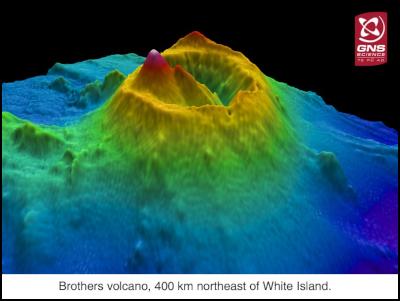Robotic Vehicles To Explore Offshore Volcano
NEWS RELEASE
27 JULY 2007
Robotic Vehicles To Explore Offshore Volcano
Unmanned vehicles will fly into the crater of an offshore volcano during the next three weeks to map it at high precision and search for possible mineral deposits.
In a New Zealand-led mission that has parallels to planetary exploration, two state-of-the-art robotic underwater vehicles will be deployed from the German research ship Sonne to gather an unprecedented amount of information about Brothers volcano, 400km northeast of White Island in the Bay of Plenty.
Parts of the large caldera (crater) at the summit of Brothers volcano, one of the bigger and more hydrothermally active of New Zealand’s offshore volcanoes, have been explored previously from surface ships and in submersibles piloted by scientists.
But on this voyage, the aim is to use the latest technology to produce a three-dimensional map of the 4km by 3km Brothers crater at a resolution of two metres.

“ That means we’ll be able to see rock formations and volcanic chimneys the size of a small car,” said project leader Cornel de Ronde of GNS Science.
The scientists, from New Zealand, the United States and Germany, will deploy a torpedo-like autonomous underwater vehicle (AUV) to fly above the surface of the crater in a grid pattern to collect a wide range of information.
Known as the Autonomous Benthic Explorer (ABE), the US-built probe from Woods Hole Oceanographic Institution knows where it is in relation to the seafloor within a couple of metres thanks to sonar and satellite guidance systems. Typically it flies about 25m above the seafloor on a programmed flight path for up to 16 hours before surfacing to have its batteries recharged.
While ABE is mapping at high resolution, scientists will lower a newly built German Remotely Operated Vehicle (ROV) – the SeaQuest 6000 – to explore other parts of Brothers crater. SeaQuest 6000 is custom-built for deep-sea research. Unlike ABE, it is connected to the ship by a fibre optic cable and bristles with instruments including manipulator arms and video cameras.
Scientists on the Sonne will use SeaQuest 6000 to closely examine seafloor features identified by ABE and features seen previously in manned submersibles.
“ The ability to use two unmanned vehicles to study the same volcano at the same time is very powerful,” Dr de Ronde said.
“ Ship time
is expensive and being able to deploy sophisticated research
tools simultaneously is a real bonus and will accelerate the
collection of high quality information.”
The main aim
of the voyage from a New Zealand perspective is to build a
three-dimensional computer model of hydrothermal venting of
Brothers volcano. Vents can be active for periods from
months to decades. As vents shut off, new ones may form in
another part of the crater and deposit metallic minerals on
the seafloor.
“ If we can understand the evolution of the hydrothermal venting inside Brothers, it will enable us to transport this understanding to other submarine volcanoes along the Kermadec Arc.
“ The end result will be a new platform for understanding the formation and economic significance of the many submarine volcanoes within New Zealand’s Exclusive Economic Zone.”
The three-week voyage, which starts on 27 July, is a collaboration between GNS Science, IFM-GEOMAR of Germany, the National Oceanic and Atmospheric Administration Ocean Exploration Programme of the US, and Woods Hole Oceanographic Institution of the United States.
German researchers are using the voyage to test their new Remotely Operated Vehicle at a range of depths up to 6km along the Kermadec Trench, which is to the east of the Kermadec Arc. The voyage is part of a long-term project at GNS Science aimed at improving the understanding of the seafloor geology within New Zealand’s Exclusive Economic Zone.
ENDS


 Financial Markets Authority: FMA Seeks Clarity From High Court On Use Of Eligible Investor Certificates In Wholesale Investment Sector
Financial Markets Authority: FMA Seeks Clarity From High Court On Use Of Eligible Investor Certificates In Wholesale Investment Sector Scion: Scion’s Novel Internship Model Connects Talent With Industry
Scion: Scion’s Novel Internship Model Connects Talent With Industry Financial Markets Authority: Westpac Admits To Misleading Representations That Resulted In $6.35m In Overcharges
Financial Markets Authority: Westpac Admits To Misleading Representations That Resulted In $6.35m In Overcharges Bill Bennett: Download Weekly - Review Of 2024
Bill Bennett: Download Weekly - Review Of 2024 Bill Bennett: One NZ scores worldwide first as Starlink direct-to-mobile launches
Bill Bennett: One NZ scores worldwide first as Starlink direct-to-mobile launches Hugh Grant: How To Reduce Network Bottlenecks
Hugh Grant: How To Reduce Network Bottlenecks



